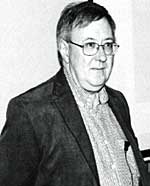Events and excursions, Autumn 2009
The Myles Thoroton Hildyard Lecture, Saturday, 17 October 2009
Gold In The Wars Of The Roses: the 15th century coin hoard from Fishpool
Dr. Barrie Cook

Dr Barrie Cook.
Although suffering from the aftermath of a heavy cold, Dr. Cook, who is Curator of Medieval and Early Modern Coinage at the British Museum, gave an enthusiastic talk on the Fishpool Gold Hoard to a packed audience at the first meeting of the autumn lecture season at the Nottingham Mechanics. Dr. Cook's research interests include the recording and publishing of medieval and early modern coin hoards and the use of city views on coins and medals of early modern Europe. He is at present working on a joint project with BBC Radio 4 to chart the history of the world through objects in the British Museum. The series is due to be broadcast from January 2010. He concentrated his talk on the coins found in the Fishpool Hoard although there were nine pieces of jewellery found with the coins but Barrie freely admitted that he is not an expert on jewellery. The coin hoard consisted of 1,237 gold coins, mostly English nobles (a noble being worth 6s. 8d. or one third of a pound), half nobles and quarter nobles. They ranged in date from 1351, when gold coinage was introduced into England, to the latest coins in the group: 63 coins of Edward IV, of a particularly heavy type issued between 1460 and August 1464. The hoard also included 233 foreign coins: issues of James II of Scotland, Charles VII of France and Philip the Good, Duke of Burgundy. Most of the nobles were made in London, but some (bearing a flag) were struck at the Calais mint. Barrie explained why some of the coins had been 'clipped'. This was not done fraudulently, but came about as a result of a revision of the currency in 1412, which lead to a reduction in the weight of the noble from 120 grains to 108 grains (a grain is equivalent to 0.0648 grams).
A lively discussion followed the talk on how and why the hoard came to be buried in the Ravenshead area. It is clear that the coins were deliberately concealed since they were found neatly stacked, suggesting that they had been in a cloth container which had disintegrated. The hoard's composition ruled out the possibility that it was wealth accumulated over many years, and any connection with neighbouring Newstead Abbey was very unlikely. It seems probable that it originally formed part of the Lancastrian Royal Treasury entrusted to someone fleeing south after the Battle of Hexham in May 1464. Why wasn't the hoard retrieved at a later date? Opinion amongst the audience varied. Some thought that perhaps the person simply forgot where he buried it; maybe in a barren landscape with no obvious landmarks, but Barrie was of the opinion that the person probably died before he was able to retrieve it and so the knowledge died with him. A very enjoyable lecture with the audience still pondering over the hoard's value and provenance as they dispersed homewards. For further information on the hoard see: Marion Archibald; 'Fishpool, Blidworth (Notts), 1966 Hoard: Interim Report', Num. Cron. Vii (1967), 133-46 J. Cherry, The Medieval Jewellery from the Fishpool, Nottinghamshire Hoard', Archaeologia 104 (1973), 307-21
Copies of both articles can be found in the Nottingham Local Studies Library, Angel Row, Nottingham.
Trevor Foulds